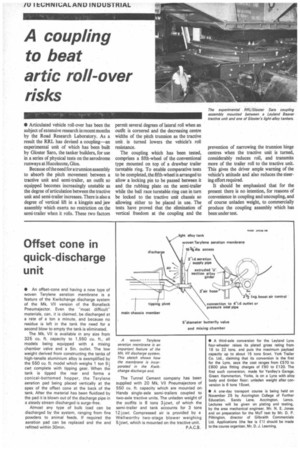A coupling to beat artic roll-over risks
Page 72

If you've noticed an error in this article please click here to report it so we can fix it.
• Articulated vehicle roll-over has been the subject of extensive research in recent months by the Road Research Laboratory. As a result the RRL has devised a coupling—an experimental unit of which has been built by Gloster Saro, the tanker builders, for use in a series of physical tests on the aerodrome runways at Hucclecote, Glos.
Because of the need for a trunnion assembly to absorb the pitch movement between a tractive unit and semi-trailer, an outfit so equipped becomes increasingly unstable as the degree of articulation between the tractive unit and semi-trailer increases. There is also a degree of vertical lift in a kingpin and jaw assembly which exerts no restriction on the semi-trailer when it rolls. These two factors permit several degrees of lateral roll when an outfit is cornered and the decreasing centre widths of the pitch trunnion as the tractive unit is turned lowers the vehicle's roll resistance.
The coupling which has been tested, comprises a fifth-wheel of the conventional type mounted on top of a drawbar trailer turntable ring. To enable comparative tests to be completed, the fifth-wheel is arranged to allow a locking pin to be passed between it and the rubbing plate on the semi-trailer while the ball race turntable ring can in turn be locked to the tractive unit chassis so allowing either to be placed in use. The tests have proved that the elimination of vertical freedom at the coupling and the prevention of narrowing the trunnion hinge centres when the tractive unit is turned, considerably reduces roll, and transmits more of the trailer roll to the tractive unit. This gives the driver ample warning of the vehicle's attitude and also reduces the steering effort required.
It should be emphasized that for the present there is no intention, for reasons of convenience in coupling and uncoupling, and of course unladen weight, to commercially produce the coupling assembly which has been under test.




































































































































































































































